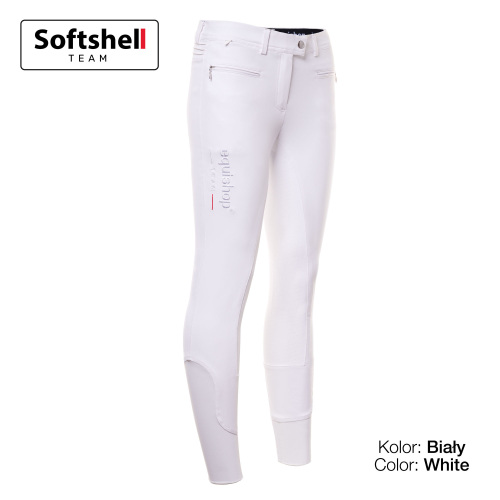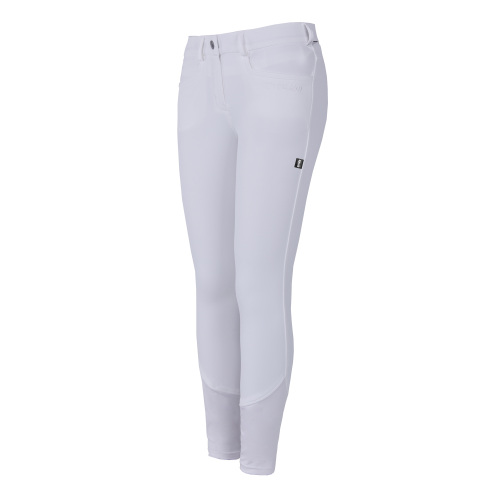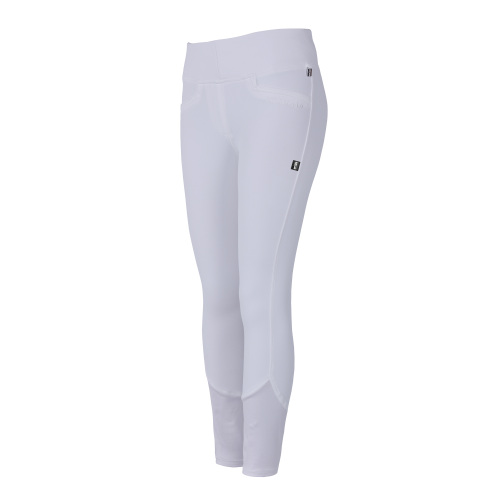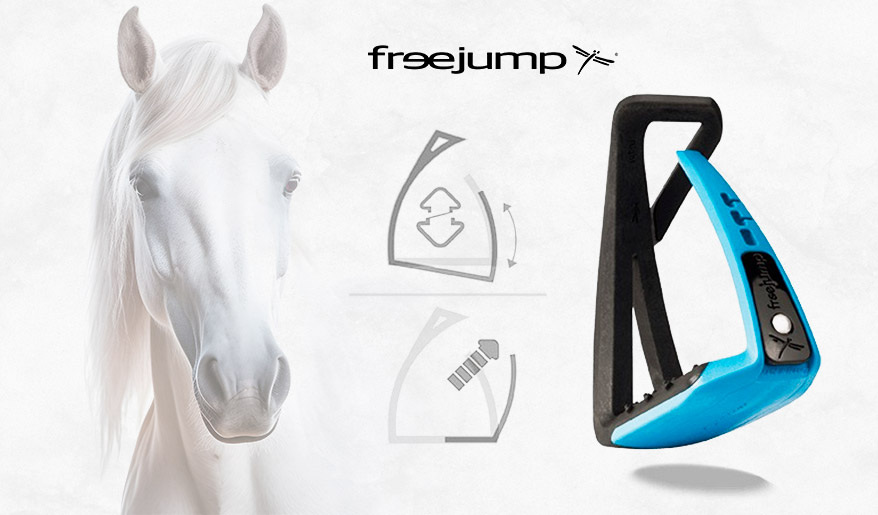
1. Bryczesy jeździeckie - co to właściwie jest?
Nieodłącznym elementem ubioru każdego jeźdźca są bryczesy (ang. breeches, choć pierwotnie w języku angielskim słowo to oznaczało spodnie kończące się pod kolanem lub w połowie łydki), specjalne spodnie do jazdy konnej, umożliwiające swobodę ruchów i prawidłowy dosiad. Charakteryzują się brakiem szwów po wewnętrznej stronie nogawki, gdzie nogi jeźdźca stykają się z siodłem lub z koniem – takie rozwiązanie zapobiega otarciom i zapewnia wygodę podczas jazdy. Obecnie sklepy jeździeckie oferują bardzo szeroki wybór tego typu spodni do jazdy – od cienkich leginsów jeździeckich na lato, przez eleganckie modele konkursowe, po wykonane z tkanin technicznych najnowszej generacji bryczesy do zadań specjalnych. Bryczesy damskie lub męskie mają równie bogatą historię – jak większość sprzętu jeździeckiego, także spodnie jeździeckie zawdzięczamy mundurom wojskowym.

2. Historia bryczesów
Współczesne bryczesy z pełnym lejem najbardziej przypominają w swoim kroju rajtuzy (niem. Reithose, spodnie do jazdy – nie mylić ze współczesnym elementem damskiej garderoby!) – obcisłe, podszyte cielęcą skórą spodnie były używane przede wszystkim w XIX wieku przez różne armie. W Polsce stanowiły część umundurowania Kawalerii Narodowej u schyłku I Rzeczpospolitej, a także ułanów i żołnierzy kawaleryjskich w czasach napoleońskich. Szczególnie obcisłą odmianą rajtuzów były pantalony, przez pewien czas kojarzone jako „ubiór polski”, następnie, w nieco zmodyfikowanej wersji, stanowiły element damskiej bielizny. Armii napoleońskiej zawdzięczamy nie tylko spodnie do jazdy – jej umundurowanie miało niebagatelny wpływ na ubiór jeździecki. Zaprojektowane tak, aby można spędzać w siodle długie godziny podczas kampanii wojskowych, w kolorach, które także dzisiaj królują na parkurach i czworobokach – białe, granatowe, czerwone, z frakiem i wąskimi spodniami jeździeckimi. Oczywisty związek z mundurem mają tzw. bryczesy kawaleryjskie, o charakterystycznym kroju: nogawka rozszerza się w części udowej, powyżej kolana, tworząc charakterystyczne „bufki”. Taki krój spodni odnaleźć możemy wśród mundurów oddziałów kawalerii służących w I wojnie światowej – ostatniej, na której przebieg konie i oddziały konne miały niebagatelny wpływ. Była to też ostatnia wojna, w której (przynajmniej na początku) armie używały kolorowych, bogato zdobionych mundurów. Rozszerzane w górnej części bryczesy kawaleryjskie nie wyszły jednak z użytku wraz ze spadkiem znaczenia oddziałów konnych – były wykorzystywane w umundurowaniu w trakcie, a także po II wojnie światowej. Obecnie, choć są mniej popularne wśród „zwykłych” jeźdźców, stanowią element munduru kawaleryjskich grup rekonstrukcyjnych i pułków ułańskich. Zawodnicy uprawnieni do używania mundurów podczas zawodów, np. wielokrotna medalistka Żaneta Skowrońska, wybierają raczej wąskie modele.
3. Kroje bryczesów i ich rodzaje
Popularność wąskiego kroju nogawki, zarówno w bryczesach damskich, jak męskich, jest związana z wygodą i praktycznością tego rozwiązania. Ściśle przylegający krój, podobnie jak brak szwów po wewnętrznej stronie nogawek, chroni przed otarciami. Podczas jazdy materiał nie roluje się, nie zwija i nie przemieszcza, zapewniając jeźdźcowi komfort w każdym z chodów. Ponadto wąskie w łydce nogawki ułatwiają dobranie i założenie oficerek bądź sztylpów. Jeźdźcy nie są jednak skazani na obcisłe bryczesy z silikonowym lejem albo skórzanym – w sprzedaży są dostępne tzw. salonki, w kroju podobne do bryczesów kawaleryjskich, poszerzone w górnej części nogawki – choć nie aż tak mocno bufiaste, jak spodnie mundurowe ułanów. Innym modelem bryczesów, które nie są przylegające w obrębie całej nogawki, są jodhpury. Ich nazwa pochodzi od miasta Jodhpur w Indiach, a ich krój jest inspirowany tradycyjnymi, indyjskimi spodniami jeździeckimi o nazwie churidar. Ten krój spodni został spopularyzowany pod koniec XIX wieku w Wielkiej Brytanii, gdy podczas Diamentowego Jubileuszu królowej Wiktorii syn maharadży Jodhpuru wystąpił w takowych wraz ze swoją drużyną polo. Obecnie jodhpury mają proste lub lekko rozszerzane nogawki, a ich krój i wzmocnienia po wewnętrznej stronie umożliwiają jazdę bez sztylpów. Do jazdy w jodhpurach używa się krótkich butów jeździeckich. Poszukując mniej popularnych krojów bryczesów trzeba uzbroić się w cierpliwość – rynek zdominowały bowiem wąskie, przylegające spodnie jeździeckie, nieustannie udoskonalane i modyfikowane dla zwiększenia komfortu jeźdźców.
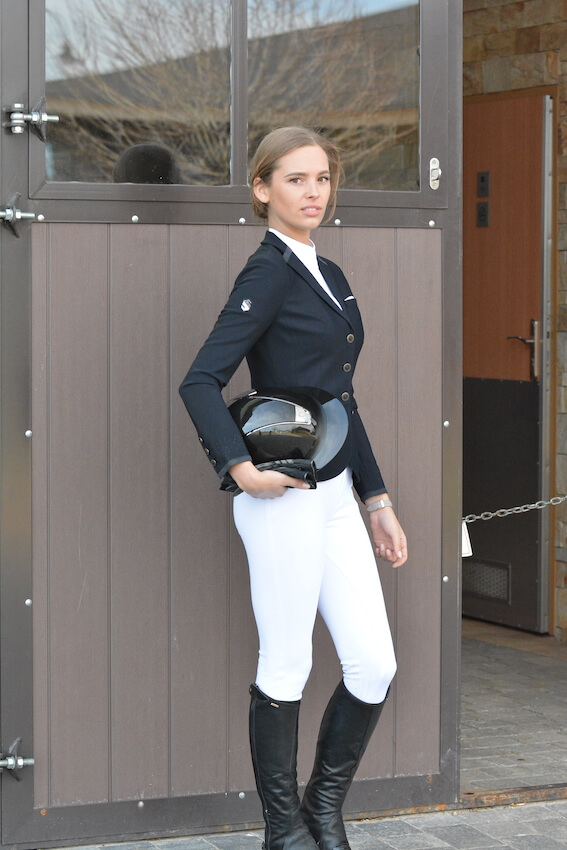
4. Lej w bryczesach
Obecnie możemy przebierać i wybierać spośród olbrzymiej różnorodności bryczesów dostępnych na rynku. Czym kierować się przy wyborze? Czym różnią się poszczególne rozwiązania krawieckie i technologiczne? Podstawowym rozróżnieniem współczesnych bryczesów jest typ leja. Lej to dodatkowe wzmocnienie po wewnętrznej stronie nogawki, naszyte w miejscach, gdzie ciało jeźdźca ściśle przylega do siodła. Zadaniem lejów jest poprawa przyczepności do siodła, a także wzmocnienie materiału w miejscach, gdzie z racji intensywnego użytkowania może on ulec szybszemu zniszczeniu. Tego typu wzmocnienia, wykonane z cielęcej skóry, naszywano w spodniach służących kawalerzystom. Początkowo także w „cywilnych” bryczesach leje wykonywano ze skóry, gładkiej bądź zamszu, jednak były one trudne w konserwacji – po praniu skórzane leje były sztywne, ulegały odkształceniom i trudno było je utrzymać w dobrej kondycji. Stopniowo tradycyjne, skórzane leje zaczęły wypierać leje z tkanin sztucznych, syntetycznej skóry czy zamszu. Ich zaletą była łatwość w utrzymaniu ich w czystości, zapewniały równie dobrą przyczepność, co leje skórzane, jednakże nie były równie trwałe. Niektóre z syntetycznych materiałów nie sprawdzały się najlepiej w swojej roli, zamiast wzmacniać spodnie w kluczowych miejscach – niszczyły się jako pierwsze. Najnowszym, obecnie dominującym na rynku materiałem, z jakiego wykonywane są leje, jest silikon, najczęściej w postaci drobnego nadruku w miejscu tradycyjnych, skórzanych bądź syntetycznych naszywek. Silikon zapewnia doskonałą przyczepność, a dzięki udoskonalaniu technologii jego nanoszenia na bryczesy z wysokim stanem na przykład nie odpada i nie kruszy się, długo zachowując swoje właściwości. Nadruki silikonowe przybierają najrozmaitsze formy: od najprostszych kropek i pasków, po całkiem wymyślne wzory – fantazyjne esy-floresy, miniaturowe wędzidła czy podkówki, a także gwiazdki, kropki, kwiatuszki, kratkę – rodzaj wzoru nie ma znaczenia dla użytkowania spodni podczas jazdy, a stanowi jedynie element dekoracyjny, dostosowany do naszych upodobań i ograniczony jedynie kreatywnością producenta.

1. Pikeur bryczesy Tessa grip pełnolejowe damskie
2. HKM bryczesy Santa Rosa Pam Function z pełnym lejem silikonowym damskie
- Lej kolanowy czy pełny?
Poza rodzajem materiału, z jakiego wykonane są leje w bryczesach, istotny jest także ich typ. Wyróżniamy dwa rodzaje lejów – kolanowe oraz pełne. Leje kolanowe, jak sama nazwa wskazuje, znajdują się jedynie po wewnętrznej stronie nogawki, na wysokości kolana, w formie skórzanej bądź syntetycznej naszywki lub silikonowego nadruku. Lej pełny obejmuje całą wewnętrzną i spodnią część bryczesów – wszędzie tam, gdzie przy prawidłowym, pełnym dosiadzie ciało jeźdźca powinno przylegać do siodła. Zarówno leje kolanowe i pełne są wykonywane z materiałów tradycyjnych, jak i silikonu. Wybór leja zależy od preferencji jeźdźca, uprawianej dyscypliny bądź stylu jazdy. Pełny lej zapewnia lepszą przyczepność, dlatego też częściej wybierany jest przez osoby trenujące ujeżdżenie, jeżdżące głównie w pełnym siadzie. Ten typ leja będzie także pomocny dla osób początkujących, które dopiero uczą się łapać równowagę w siodle i prawidłowo siedzieć – dzięki dobrej przyczepności na większej powierzchni ułatwi utrzymanie się w siodle. Z kolei lej kolanowy chętnie wybierają osoby trenujące skoki przez przeszkody: nie „trzyma w siodle” tak mocno, jak lej pełny, ale zarazem w części kolanowej, bardzo ważnej przy jeździe w półsiadzie i skoku, zapewnia dobrą przyczepność.
Czy to bryczesy damskie z pełnym lejem czy bryczesy męskie powinny kończyć się nad kostką i ściśle przylegać w tym miejscu, aby nie zwijały się i nie uciskały jeźdźca. W związku z tym starsze modele były przy kostce zakończone rzepami, umożliwiającymi dopasowanie szerokości nogawki i wygodne nałożenie na spodnie podkolanówek jeździeckich. W nowszych modelach rzepy zastępowane są cienką, elastyczną tkaniną, która dopasowuje się do obwodu nogi jeźdźca, ułatwiając także dobranie spodni do wzrostu – nadmiar materiału, zbierający się w okolicach u nieco niższych jeźdźców, nie będzie się zwijał ani rolował, dając wyższym osobom nieco „zapasu”.

- Kolory bryczesów. Jaki kolor wybrać?
Najczęściej bryczesy dla dzieci, jak i dorosłych występują w ciemnych, stonowanych kolorach – każdy, kto czyścił wierzchowca, który zażył kąpieli błotnej, zrozumie, dlaczego tak jest… Jednakże strój jeździecki już dawno przestał przypominać mundur, a producenci odzieży i sprzętu chętnie sięgają po coraz odważniejsze kolory i wzory. Tradycyjną czerń, granat, ciemną zieleń i szarości, choć wciąż popularne i dostępne w ofercie wszystkich marek, powoli wypierają coraz ciekawsze kolory. Czym się kierować przy wyborze koloru bryczesów? Przede wszystkim okazją – jeśli szukamy bryczesów na zawody, należy wybrać białe lub kremowe, stanowiące element stroju konkursowego. Oczywiście w warunkach stajennych białe bryczesy damskie i męskie nie są zbyt praktyczne (podobnie jak białe czapraki), dlatego też na co dzień lepiej wybrać nieco ciemniejsze kolory. W ofercie bryczesów wzorzystych tradycyjna, elegancka kratka to tylko jedna z możliwości – coraz więcej, zwłaszcza wśród bryczesów młodzieżowych i dziecięcych, wesołych i wielokolorowych modeli. Poza kolorem i wzorem warto przemyśleć także wybór materiału. Coraz bardziej popularne stają się bryczesy dżinsowe, często z domieszką elastanu, co sprawia, że spodnie przylegają do sylwetki. Na lato warto wybrać modele z cieńszych tkanin oraz w jaśniejszych kolorach, na falę upałów można pokusić się o cieniutkie leginsy jeździeckie. Z kolei na zimniejsze miesiące warto rozejrzeć się za bryczesami z tkanin technicznych – np. z softshellu, który jest nie tylko ciepły, ale także wiatro- i wodoodporny, docenią go nie tylko jeźdźcy, ale i stojący na hali długie godziny trenerzy.
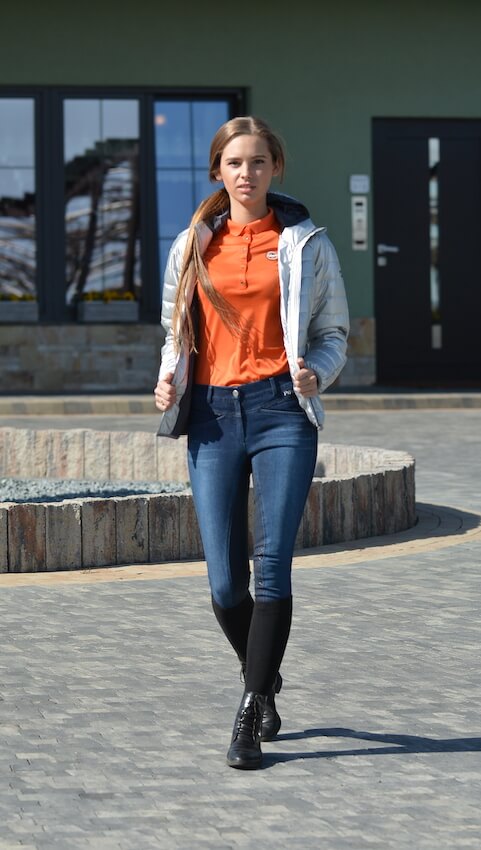
1. Pikeur Elfa jeans bryczesy damskie z pełnym lejem silikonowym
Spodnie jeździeckie, choć były kiedyś elementem munduru wojskowego, dzisiaj nie przypominają już XIX-wiecznych rajtuzów czy pantalonów. Najpopularniejsze, wąskie modele, są nieustannie udoskonalane i unowocześnianie przez producentów, aby ułatwić i uprzyjemnić jazdę konną, sprostać trudnym i zmiennym warunkom pogodowym, ale też trafiać w rozmaite gusta – oferta jest tak szeroka i różnorodna, że każdy na pewno znajdzie coś dopasowanego do swoich potrzeb i stylu.
Szukasz bryczesów jeździeckich, które będą odpowiadały Twoim wymaganiom? Sprawdź naszą ofertę w sklepie jeździeckim Equishop: bryczesy do jazdy konnej, czapraki, buty jeździeckie.
Masz pytania? Zadźwoń lub napisz do nas.
Aktualności ze sklepu jeździeckiego Equishop:









